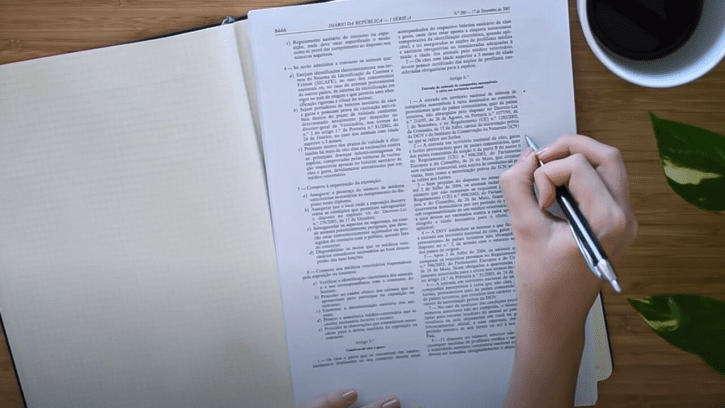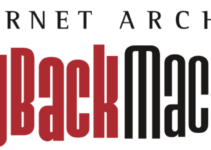As an academic student, I have always been able to score high in every class. My effective note-taking method is one of the main reasons for my high grades and popularity as the best student.
The thought “Why bother reading so much if I’ll just forget everything I’ve read?” may cross your thoughts. Your method of note-taking may hold the secret to the solution.
I’ll also give you some pointers and hacks for making the most of each method. Let’s get into each detail of Note Taking methods I use daily.
How To Take Notes (7 Popular Ways For Note Taking)
What is Note taking?
Are you looking for the greatest LMS platform? Get Here to know more
As a student, note-taking is an essential skill that can greatly benefit us in college and university. By recording and organizing information from lectures, readings, and other sources, you can better understand and retain the material you are learning. Not only that, but effective note-taking also helps you stay organized and prepare for exams.I use many different note-taking methods, such as the Cornell method, the outlining method, and the mapping method. Each method has unique advantages, and you must experiment and find the best one.By actively engaging with the material and organizing it in a way that makes sense, you are more likely to remember and understand the information long-term. Additionally, note-taking can help us stay organized and on track with our studies, making it easier to prepare for exams and complete assignments on time.Here I am going to share 7 Popular Note-taking methods I use every day for revising my subjects, and I bet you that they are the best.
1. Outline Method
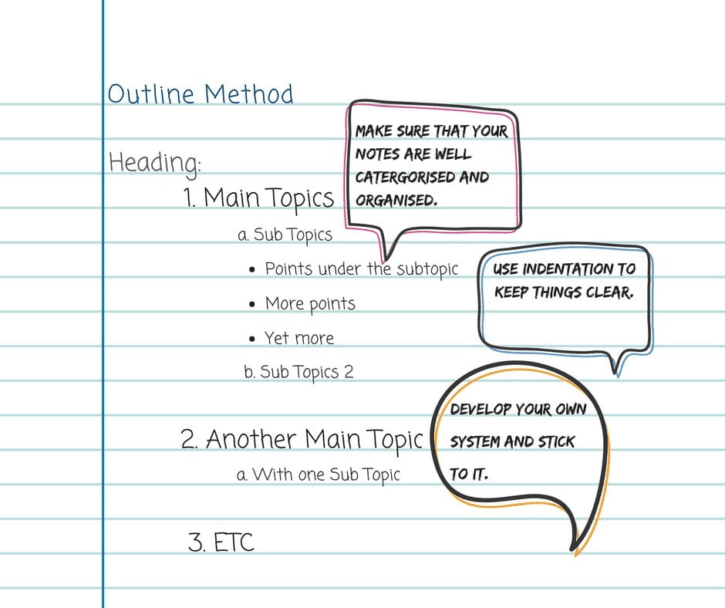
- Start by writing the main topic or idea at the top of the page.
- Underneath the main issue, write the main subtopics or supporting ideas.
- Indent each subtopic and report any additional subtopics or details underneath.
- Use bullet points or numbers to organize the information.
- Use abbreviations and symbols to save space and increase efficiency.
The Outline Method is best for verbal presentations, such as lectures or speeches. It is also helpful for organizing and summarizing information.
Pros:
- It makes it easy to identify the main ideas and supporting details
- It allows you to see the relationships between different pieces of information.
- It helps you to summarize and condense information into a more manageable format.
- It is easy to follow and understand.
Cons:
- This method may take a lot of work to capture detailed information.
- It might take a lot of work to keep up with the pace of the lecture.
- It may not be the best method for visual presentations or when you need to capture detailed information
- It can take time to add or reorganize information later.
I would use this method while preparing for my assignments or finals. This becomes my future reference guide when in a hurry.
2. Mind Mapping Method
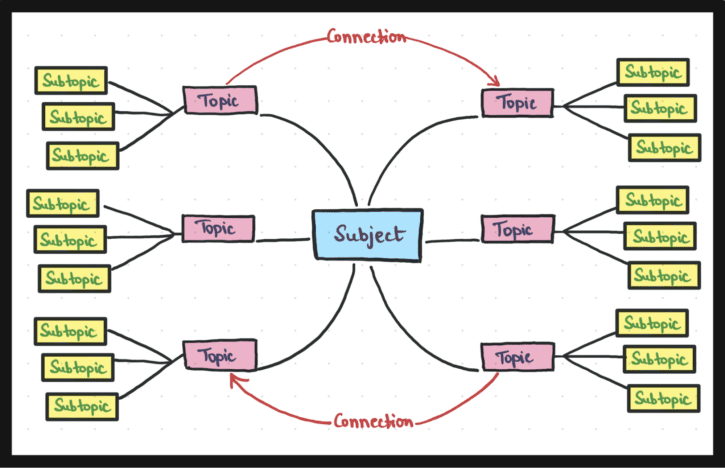
- Start by writing the main topic or idea in the center of the page.
- Draw branches or lines from the main issue, and write related ideas or subtopics on them.
- Draw additional components or cables to connect related ideas or subtopics.
- Use colors, images, and symbols to make the map more visually appealing and memorable.
- Review and reorganize the map as needed.
This method is unique for brainstorming new ideas and writing. It helps when I am stuck correlating between different topics. This is the best method for problem-solving.
Pros:
- It allows you to see the relationships between different pieces of information.
- It helps you to organize and summarize data visually.
Cons:
- Cannot use while live or online classes
Although, there may be better methods for capturing detailed information or giving verbal presentations. However, I recommend you use this method when revising old chapters and stick it on each chapter’s front page.
3. Cornell Note Taking Method
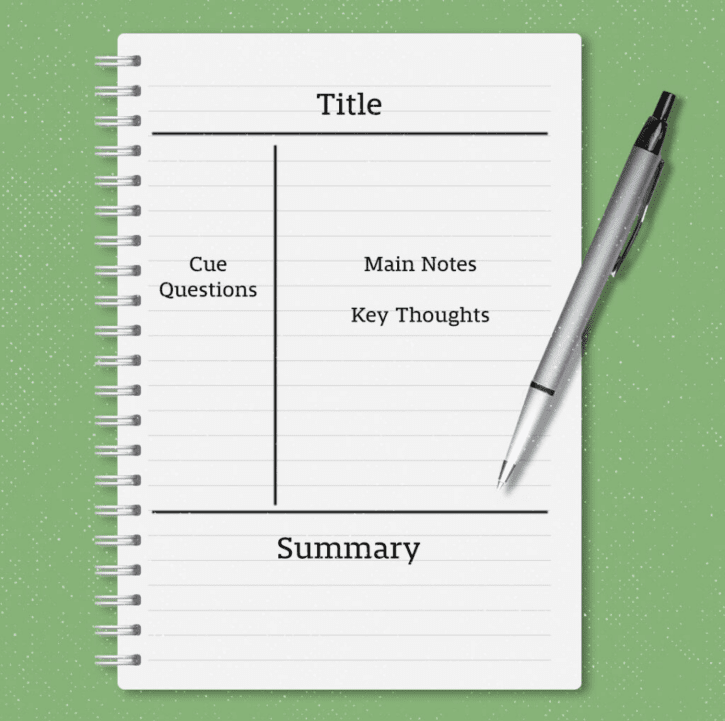
- The cue column,
- For Quick prompts
- Questions
- Use cases
- Memory jogs
- the note-taking column
- For writing the actual notes
- Using bullets
- Shorthand information
- Subtopics
- a summary section
- Summary of the Note-taking column
- Concise format
- For future review
This method is designed to help students organize their notes and review them more effectively.Here are the detailed steps for using the Cornell Method:
- Draw a line down the center of the page, creating a note-taking column and a cue column.
- Write the main ideas and key points in the note-taking column during the lecture or presentation.
- In the cue column, write keywords or phrases to help you recall the information in the note-taking column.
- After the class or presentation, review your notes and write a summary of the main points in the summary section at the bottom of the page.
- Use the cue column to review your notes and test your understanding of the material.
The Cornell Method is best used for lectures, presentations, or other verbal presentations. It can also help study and review the material.
Pros:
- It helps you organize your notes and make connections between different pieces of information.
- It allows you to review the material more effectively.
- It helps you to identify the main ideas and key points.
- It makes it easy to review and study the material later.
Cons:
- It can take up a lot of space on a page.
- It may take work to keep up with the pace of the lecture.
- There might be better methods for visual presentations.
- It may not be suitable for capturing detailed information.
This method is also not suitable for taking notes in class. I only use this method when preparing for a complex subject that needs to be condensed into short bits and where essential questions are mapped.
4. The Sentence Method
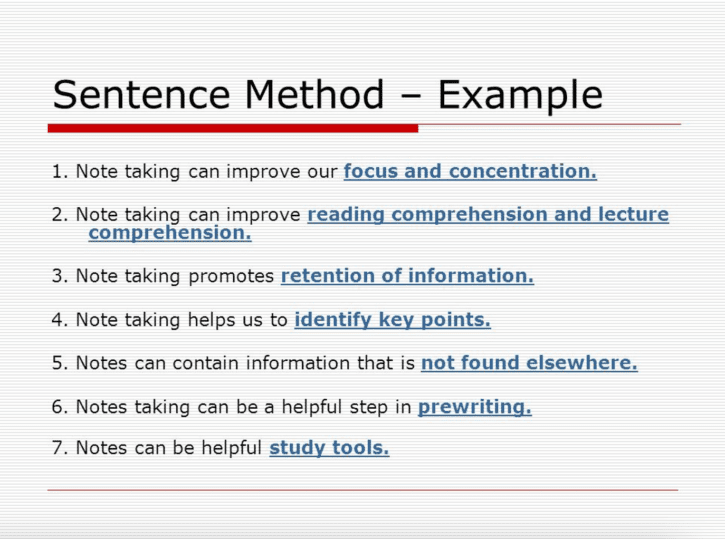
- Start with the Subject or topic of the lecture
- Write whatever you are hearing in small bits in sentences
- Write in multiple lines instead of a para
- Use bullets or numbers or any form that appears as a list
Pros:
- Covers all the critical information shared during the lecture
- Simple and easy-to-use method for beginners
- All the data is easy to view and looks more organized.
Cons:
- The only downside is that there needs to be branching out or identifying sub-topics.
But I strongly recommend this method to all my classmates whenever they ask me. How do I top every time in every Subject?This acts as stand-alone material for me to refer to what is taught in the lecture. I implement the rest of the methods based on this information and data.I need this material to perform compelling studies in any other methods.
5. Morse Code method:
Initially, when I was very new to this Note taking method, it took a lot of work to keep track of different topics, which one to revise, which contained critical information, and I wasted tons of my time turning the pages back and forth.
Then I came across through Morse code method, which helped me. This was my life savior.
Although it wasn’t a popular method of Note-taking, I recommend this for whoever hates writing tons of information and categorizing it can go for this method.
This method uses dots & Dashes to organize the topic.
Here is how you can do it:
- Identify the need for reading the topic. Do you want this for your exam and mark out important questions, or just read it for future reference?
- Use a dot if you find the topic essential or relevant to your reading goal.
- Use dash if the topic you have dotted has an example that makes more sense and you need to use it elsewhere in the future.
This might sound very gibberish to you. But after completing the reading, you will find the topic with dots and dashes, which you can refer to in the future.
Pros:
- Eliminate the task of heavy writing and organizing
- Anyone can do it and its not very time consuming
- You can consume a lot of information and save time simultaneously.
Cons:
- The only problem with this method is that you will need help to organize this.
- You must carry your whole textbook or material with you whenever you are preparing for something important.
Irrespective of the heavy lifting, I recommend this if you are a beginner who hates writing tons of information but wants to score high in your subjects.
6. The Charting Method:
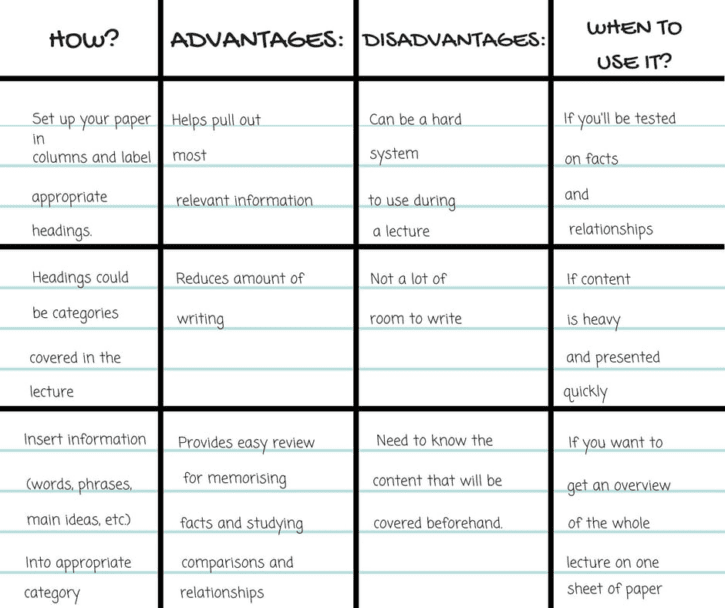
- Start by identifying the main categories or ideas you want to compare and contrast.
- Create a chart or table with columns and rows to organize the information.
- Fill in the chart or table with the relevant information, including specific examples, facts, or statistics.
- Use color coding, symbols, or other visual cues to help you better understand the relationships between different pieces of information.
- Review and reorganize the chart or table as needed.
Charting Method is great for comparing and contrasting different pieces of information and understanding complex relationships between concepts.
Pros:
- Classify the topics or information in a more detailed and logical manner
- It helps you save tons of time invested in revision
Cons:
- Not fit for all subjects
- Must avoid if the Subject contains lots of information
- Not best for equations from Maths and Science.
I have been using this method for over a year now, and it works best when I analyze topics related to Facts, History and also if I have to remember some statistics. I use this method as an alternative to Prompt cards or Flash cards which are a bit more costly.
7. Flow Notes
If you are unsure of which note-taking techniques to employ prior to a lecture, this strategy may work for you.
You just collect ideas as you go, dropping them on the screen as single words or short sentences and connecting them with arrows, circling, etc. as you recognize links in the content.
It is some kind of free-form mind map. This can also be accomplished with a succession of sentences, however, unlike an outline, each statement is of equal importance.
Do you want the best LMS platform and get a 50% discount? To get discount coupons and save money, click here
Quick Links:
- How Can We Learn From Our Mistakes?
- Top Typing Software
- Top Memory Techniques to Learn Faster
- The Market For Online Learning Will Reach in billion
- How To Study Online
- How To Find A Right Scholarship?
- Benefits Of Distance Learning
- How Online Learning Affects Mental And Physical Health?
Final thoughts on How to Take Notes in 2024
Here comes the end of the most popular and favorite note-taking methods that helped me score higher than anyone in my class.Pick one method depending on your convenience and try to perfect it. Later on, you can add more approaches to your study techniques.If you find these methods helpful and exciting, let me know in the comment section below. I love to know your thoughts on this.Happy Note taking!

